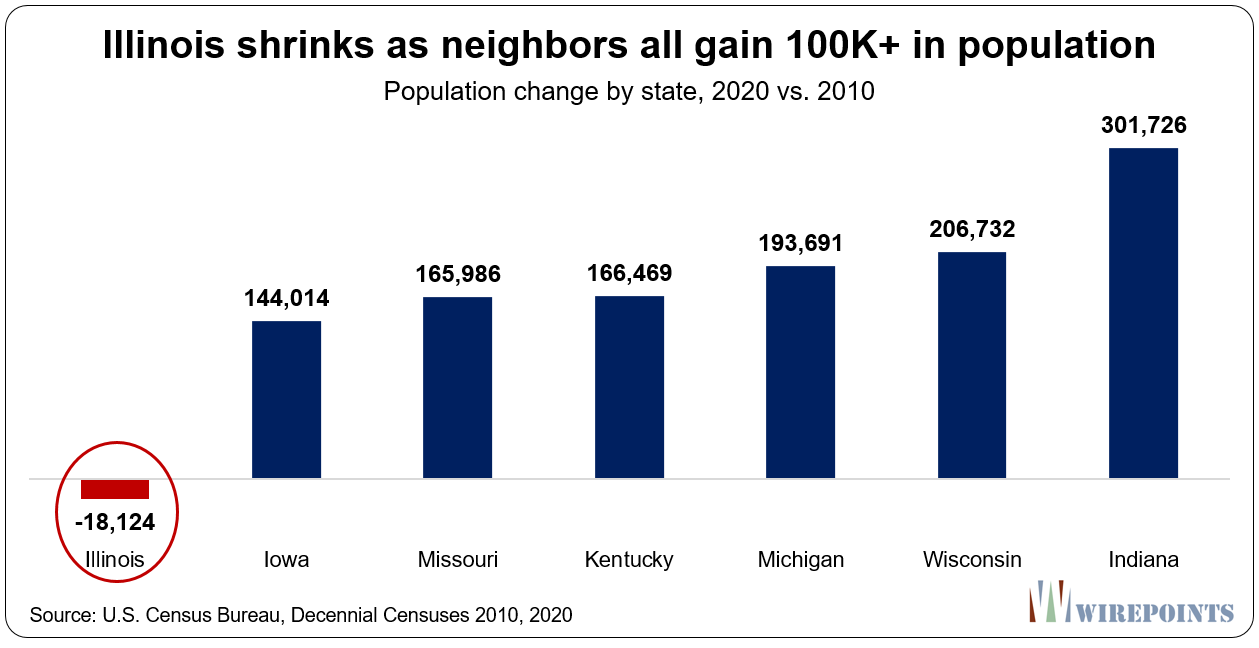By: Ted Dabrowski and John Klingner
Eighty-seven of Illinois’ 102 counties lost population between 2010 and 2020, according to the latest data release from the Census Bureau. All 87 of the counties were in downstate Illinois, while Cook County and the collar counties grew, albeit slowly.
The county-by-county data comes a few months after the Census released top-line data showing Illinois was one of just three states to lose population in the last decade. Illinois’ overall population declined by 18,000 people from 2010 to 2020.
In all, those 87 counties lost a total of 177,000 people, offset largely by the 15 counties that gained 159,000.
The broad-based decline for so many Illinois counties and cities spells trouble for a state that needs significant population growth to repay its ever-growing debts, driven largely by pension shortfalls. As debts grow and populations shrink, the burden grows on those who remain.
These new population numbers come with some controversy. Previous estimates from the Census showed Illinois was expected to lose 250,000 people, with 93 counties shrinking across the state.
Now the decennial numbers show Illinois’ actual losses were smaller than those long-running estimates.
Many lawmakers and pundits have cheered that the state’s losses weren’t as big as expected, as if the limited declines were some kind of win for Illinois.
But that’s far too dismissive of what the data shows us. As a state, Illinois was only one of only three states to shrink in the nation besides West Virginia and Mississippi.
The less-than-expected population loss also doesn’t change the reality that Illinois is still bleeding tens of thousands of people and their incomes to other states each year. The fact that Illinois shrank overall means the state lost more people to domestic out-migration over the decade than it gained from its natural increase (births minus deaths) and net international immigration. Illinois netted a loss of nearly 750,000 people to other states from 2010 to 2020, based on IRS state-to-state migration data.
We’ll never know how much Illinois’ push to lift up the Census numbers in 2020 impacted the population numbers, but the state’s efforts shouldn’t be ignored.
From Politico Illinois:
It may be proof that the heavy lifting to get residents counted last year actually worked. “We built a coordinated, robust, statewide effort to reach millions of Illinois residents, particularly those in hard-to-count communities, and it proved to be tremendously successful,” Gov. J.B. Pritzker said in a statement to Playbook. He pointed to a “boots on the ground” effort that included 400 organizations, coordinated by 31 “regional intermediaries.” It was all fueled by $47.8 million in funding.
It’s a hard question. Were the lower-than-expected population losses a result of the Census’ poor intercensal estimates, or due to a successful response campaign by Illinois to increase survey participation in 2020 compared to 2010?
Biggest winners and losers
Cook County was the state’s biggest winner with an increase of over 80,000 residents over the decade. The rest of the collar counties – Will, DuPage, Lake, Kane and McHenry – also had their populations grow, though the Chicago Tribune noted that “population growth in suburban Cook and the five collar counties stalled to what is easily the slowest rate since 1950.”
The city of Chicago increased in population by 50,000, a surprise after the yearly Census estimates showed the city had lost population for six straight years. As said above, it’s difficult to know how much of that growth was driven by the state’s enhanced Census efforts.
Kendall County had the largest growth as a percentage of its 2010 population, growing by nearly 19,000 people, or 15 percent, over the decade.
 The biggest losers in the state were St. Clair, Winnebago and Vermilion counties, which lost 7,000 to 12,000 residents. That’s not surprising, as those counties are home to the struggling downstate cities of East St. Louis, Rockford and Danville.
The biggest losers in the state were St. Clair, Winnebago and Vermilion counties, which lost 7,000 to 12,000 residents. That’s not surprising, as those counties are home to the struggling downstate cities of East St. Louis, Rockford and Danville.
The biggest loser of all was Alexander County, home of Cairo, which lost over a third of its population – 3,000 people – over the decade.
The bleed continues
Illinois’ losses in population have to be taken in context with what’s happening in other states – most importantly, the neighbors it competes directly with for people and businesses.
All of Illinois' neighbors managed to grow over the decade by 140,000 people or more. Indiana was the clear winner, increasing its population by over 300,000.
 Anyway you cut it, lawmakers will have to take into account the fact that Illinois is bleeding people.
Anyway you cut it, lawmakers will have to take into account the fact that Illinois is bleeding people.
Until they do, the losses will continue.
Read more about Illinois' population problems:


 A set of state lawmakers want to extend CPS’ current school closing moratorium to February 1, 2027 – the same year CPS is set to transition to a fully-elected school board. That means schools like Manley High School, with capacity for more than 1,000 students but enrollment of just 78, can’t be closed for anther three years. The school spends $45,000 per student, but just 2.4% of students read at grade level.
A set of state lawmakers want to extend CPS’ current school closing moratorium to February 1, 2027 – the same year CPS is set to transition to a fully-elected school board. That means schools like Manley High School, with capacity for more than 1,000 students but enrollment of just 78, can’t be closed for anther three years. The school spends $45,000 per student, but just 2.4% of students read at grade level. Hopefully, all media will get the message, in Illinois, too.
Hopefully, all media will get the message, in Illinois, too. Ted joined Tom Miller of WJPF to talk about Illinois’ highest-in-the-nation property taxes, why lawmakers don’t want to touch the tax’s cost drivers, just how much Illinoisans’ tax burden has grown over the decades, why Gov. Pritzker failed to meet his promise to reform property taxes, and more.
Ted joined Tom Miller of WJPF to talk about Illinois’ highest-in-the-nation property taxes, why lawmakers don’t want to touch the tax’s cost drivers, just how much Illinoisans’ tax burden has grown over the decades, why Gov. Pritzker failed to meet his promise to reform property taxes, and more.
Great, so the liberal counties, or those turning liberal, are gaining population while the good counties are shrinking. This state is doomed. Must exit ASAP!
hi,my name is JB,ive got a good idea,lets raise taxes and fees on everything and everyone,at the same time we will give away more free stuff for all the people that depend on the government,oh yeah,we will also promise the ctu and all public sector employees more and more,done deal,sounds like an awesome idea!-thank you all for your support,i know i ll get re-elected!
Anyway to strip out the illegal aliens from the headcount? Last I saw Illinois had ‘welcomed’ in +500k illegals, at a cost of $B’s to taxpayers.
It’s a no win situation for taxpayers. If residents stop leaving Dems will think they are doing a good job and continue with more of the same. If residents keep leaving those left behind must pay the taxes of those that left.
I haven’t seen the racial breakdown, but I’d wager Hispanic population grew while African American population declined?
In Chicago, the hispanic population increased about 40k while black population decreased by 85k. Whites increased about 9k and asians 45k.
Thanks. So any legislators spiking the ball on these numbers are celebrating a decline in the Black population. Not a good look.
It should make it interesting when the hispanic population wants additional representation at the expense of the black population. Identity politics at its finest. Grab some popcorn and watch them eat their own.
So if the state put forth the same effort counting people in 2010 as they did in 2020, it might’ve been a wash? I guess some sort of precedent has been set.
Chicago has always had poor census turnout. It also has some of the worst mail service. Both of these despite tremendous government spending. The money just disappears and the result is poor performance.
More empty headed Democrats, fewer tax producers.
Atlas is shrugging.